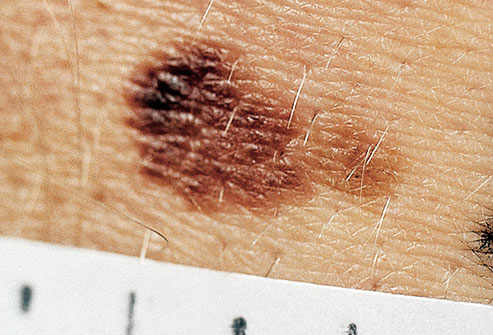In our daily routine, we have certain chores that we have to do on a periodic basis, like we would check the air in car tires on a weekly basis, or oil change monthly and furnace filters annually. We do this so that our personal property functions well, but how many of us can claim to do such kind of routines to our body for health? For example, we should actually check the mole on a monthly basis to see if there are any irregularities or skin cancers. So, how to tell if a mole is cancerous? Read on to get the answers.

How to Tell If a Mole Is Cancerous
A mole has the following features in the usual case:
- It has uniform color which is usually brown. However, it can be found in different colors like black, red, pink, tan, blue, colorless or even skin colored.
- It has round shape, is slightly raised or flat.
- It has the same appearance over months.
If you want to know how to tell if a mole is cancerous, the first sign would be appearance of a new spot, or changes in the existing mole. It could be in the color, shape or size of the mole. You can also follow the ABCDE rule, which helps in determining the signs of melanoma.
- Asymmetry: One half of the mole is not same as the other half.
- Border: The border becomes irregular. It has a blurred outline, is ragged or notched. Blurred outline is caused when the pigment spreads in the skin around the mole.
- Color: It is uneven and can have shades of tan, brown, black with pigments of gray, red, white, pink or blue.
- Diameter: The size of the mole changes or increases. They can be small but are more than 6 mm wide.
- Evolving: The mole changes within weeks or months.
Besides, the following symptoms or signs can also be a sign of a mole becoming cancerous:
- Pain: If you find any mole which is tender or painful to touch and has blood or fluid oozing from it, a skin examination should be done immediately.
- Do not heal: If a mole does not heal with time despite application of ointment or being cleaned, it can be risk for cancer.
- Bleeding: If a mole bleeds or has a rough, dry and scaly texture, becomes itchy, you should get it checked.
- Heredity: Skin cancer can be passed on if anyone in the family has a history of the disease.
Notes:
- One has to remember that not all melanomas might fit the characteristics mentioned above. Any new mole should be checked out by a dermatologist.
- Men usually have melanomas on the back and women have it on the lower leg.
The video below will tell you more about melanoma.
How to Diagnose If a Mole Is Cancerous
Once you have understood how to tell if a mole is cancerous, you can get it confirmed by seeing a doctor, who will use the following methods to make sure it.
1. Skin Cancer Screening
Screening can be done by a professional who will examine you from head to toe periodically. You can also do it at home, where you will have to know the difference between moles and freckles and normal skin marks. It can be done in front of a full length mirror and using a hand held mirror to reach the hard-to-see areas. Ensure that each and every part of the body is checked, like groin, scalp, space between toes, soles and fingernails.
Screening from time to time may or may not be recommended by certain organizations. You should consult your doctor and see what would be the best approach for you.
2. Biopsy
You can sometimes detect a cancerous mole by looking at the skin, but to confirm it, a biopsy is required. A biopsy involves removing a part or whole of the mole and analyzing it by a pathologist. The following types of biopsy can be done:
- Punch biopsy: Circular blade is pressed in the skin around the melanoma and a round piece of skin is removed for testing.
- Excisional biopsy: In this one, the entire mole is removed along with some part of normal skin around it.
- Incisional biopsy: Only the part of the mole with irregularity is removed and analyzed in lab.
The type of biopsy will be determined based on your condition. Usually the doctor would prefer to perform a punch or excisional biopsy to remove the entire mole. When the mole is very large, incisional biopsy will be done.
